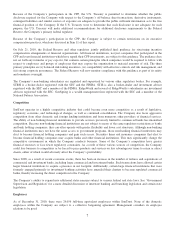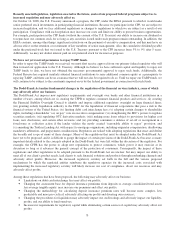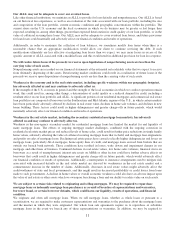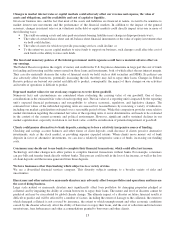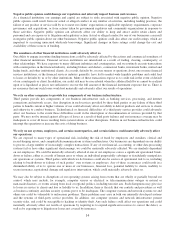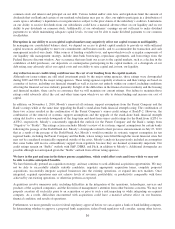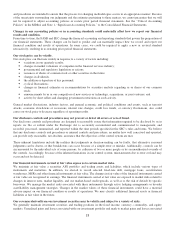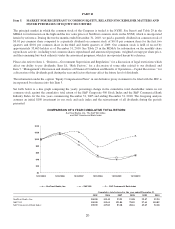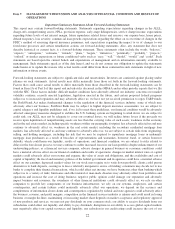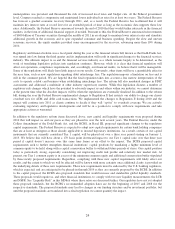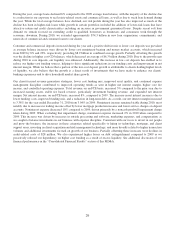SunTrust 2010 Annual Report Download - page 32
Download and view the complete annual report
Please find page 32 of the 2010 SunTrust annual report below. You can navigate through the pages in the report by either clicking on the pages listed below, or by using the keyword search tool below to find specific information within the annual report.common stock and interest and principal on our debt. Various federal and/or state laws and regulations limit the amount of
dividends that our Bank and certain of our nonbank subsidiaries may pay us. Also, our right to participate in a distribution of
assets upon a subsidiary’s liquidation or reorganization is subject to the prior claims of the subsidiary’s creditors. Limitations
on our ability to receive dividends from our subsidiaries could have a material adverse effect on our liquidity and on our
ability to pay dividends on common stock. Additionally, if our subsidiaries’ earnings are not sufficient to make dividend
payments to us while maintaining adequate capital levels, we may not be able to make dividend payments to our common
stockholders.
Disruptions in our ability to access global capital markets may negatively affect our capital resources and liquidity.
In managing our consolidated balance sheet, we depend on access to global capital markets to provide us with sufficient
capital resources and liquidity to meet our commitments and business needs, and to accommodate the transaction and cash
management needs of our clients. Other sources of funding available to us, and upon which we rely as regular components of
our liquidity risk management strategy, include inter-bank borrowings, repurchase agreements, and borrowings from the
Federal Reserve discount window. Any occurrence that may limit our access to the capital markets, such as a decline in the
confidence of debt purchasers, our depositors or counterparties participating in the capital markets, or a downgrade of our
debt rating, may adversely affect our capital costs and our ability to raise capital and, in turn, our liquidity.
Any reduction in our credit rating could increase the cost of our funding from the capital markets.
Although our issuer ratings are still rated investment grade by the major rating agencies, those ratings were downgraded
during 2009 and 2010 by the major rating agencies. These rating agencies regularly evaluate us and their ratings are based on
a number of factors, including our financial strength as well as factors not entirely within our control, including conditions
affecting the financial services industry generally. In light of the difficulties in the financial services industry and the housing
and financial markets, there can be no assurance that we will maintain our current ratings. Our failure to maintain those
ratings could adversely affect the cost and other terms upon which we are able to obtain funding and increase our cost of
capital.
In addition, on November 1, 2010, Moody’s removed all systemic support assumptions from the Parent Company and the
Bank’s ratings while at the same time upgrading the Bank’s stand-alone bank financial strength rating. The combination of
these two actions resulted in the confirmation of the Parent Company’s senior credit ratings at Baa1/P-2. However, the
combination of the removal of systemic support assumptions and the upgrade of the stand-alone bank financial strength
rating did lead to a one-notch downgrade of the long-term and short-term senior credit ratings for the Bank from A2/P-1 to
A3/P-2, respectively. Moody’s concurrently upgraded the outlook for the Parent Company and the Bank’s ratings from
“Negative” to “Stable”. This ratings action concludes Moody’s review of its systemic support assumptions for certain banks
following the passage of the Dodd-Frank Act. Moody’s downgrade related to their previous announcement on July 27, 2010
that as a result of the passage of the Dodd-Frank Act, Moody’s would reconsider its systemic support assumption for ten
regional banks, including the Parent Company and the Bank, whose ratings were lifted through the recent financial crisis but
may not be considered systemically supported outside of the crisis. Moody’s analysis has previously included an assumption
that some banks will receive extraordinary support from regulators because they are deemed systemically important. Our
credit ratings remain on “Stable” outlook with S&P, DBRS, and Fitch, in addition to Moody’s. Additional downgrades are
possible although not anticipated given the “Stable” outlook from all four rating agencies.
We have in the past and may in the future pursue acquisitions, which could affect costs and from which we may not
be able to realize anticipated benefits.
We have historically pursued an acquisition strategy, and may continue to seek additional acquisition opportunities. We may
not be able to successfully identify suitable candidates, negotiate appropriate acquisition terms, complete proposed
acquisitions, successfully integrate acquired businesses into the existing operations, or expand into new markets. Once
integrated, acquired operations may not achieve levels of revenues, profitability, or productivity comparable with those
achieved by our existing operations, or otherwise perform as expected.
Acquisitions involve numerous risks, including difficulties in the integration of the operations, technologies, services and
products of the acquired companies, and the diversion of management’s attention from other business concerns. We may not
properly ascertain all such risks prior to an acquisition or prior to such a risk impacting us while integrating an acquired
company. As a result, difficulties encountered with acquisitions could have a material adverse effect on our business,
financial condition, and results of operations.
Furthermore, we must generally receive federal regulatory approval before we can acquire a bank or bank holding company.
In determining whether to approve a proposed bank acquisition, federal bank regulators will consider, among other factors,
16



